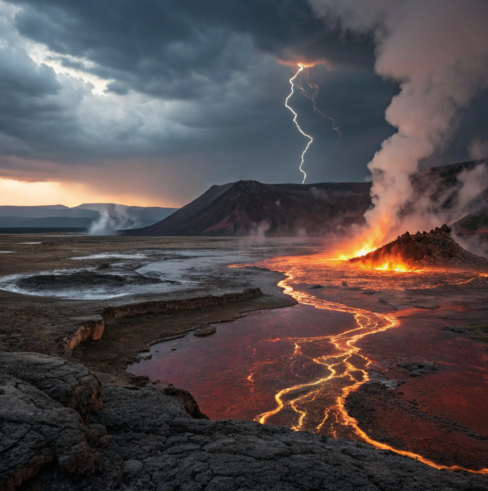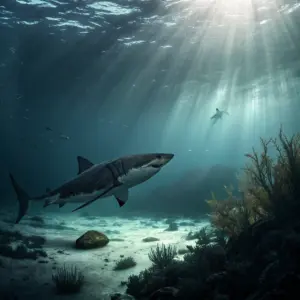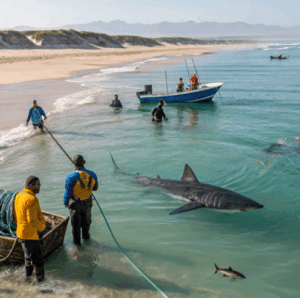A Hellish Birthplace for Life
The Hadean Eon—Earth’s Fiery Inception
Around 4.5 billion years ago, Earth emerged from a swirling disk of gas and dust encircling the Sun. This violent birth kicked off what scientists call the Hadean Eon—named after Hades, the Greek god of the underworld. For the next 500 million years, Earth was no paradise: it was a molten sphere with no oceans, no solid ground, and relentless meteorite strikes.
Yet, as surreal as it sounds, life may have already started during this chaos.
Old Assumptions vs. New Revelations

For decades, the prevailing theory was that life took hold around 3.8 billion years ago, once Earth had cooled down. That’s when the oldest known fossils date back to—a safe guess, considering the planet’s earlier conditions seemed inhospitable to life.
But now, groundbreaking research published in Nature Ecology & Evolution challenges this timeline entirely. The study suggests that the Last Universal Common Ancestor (LUCA)—the microbial forebear of all living organisms—emerged a staggering 4.2 billion years ago. That’s 400 million years earlier than previously thought.
How Did Scientists Trace Life Back That Far?
No Fossils, No Problem
The Hadean Earth didn’t preserve fossils well—if at all. With molten rock everywhere, any early lifeform would’ve likely been vaporized or erased by time. But instead of fossils, scientists turned to molecular analysis.
By analyzing the genetic makeup of modern microbes and using evolutionary modeling, researchers reconstructed LUCA’s biological blueprint—bypassing the need for physical evidence. And what they found was remarkable.
LUCA Was Anything But “Primitive”
LUCA wasn’t just some blob in a thermal pool. According to the study, it had a genome of about 2.5 million base pairs and could produce roughly 2,600 proteins—comparable to today’s prokaryotes.
Here’s what else LUCA could do:
| Feature | Description |
|---|---|
| Energy Production | Acetogenesis—converting hydrogen and CO₂ into energy |
| Oxygen Use | Anaerobic (lived without oxygen) |
| Complexity | Genetically similar to modern bacteria |
| Defense | Possessed a rudimentary immune system |
A Survivalist from Day One
That early immune system? It likely evolved to fight off ancient viruses. Yes—even 4.2 billion years ago, nature was already locked in an evolutionary arms race. Life wasn’t just forming—it was defending itself.
Life Thrived in a Hostile World
Earth’s Transformation Didn’t Deter LUCA
At the time LUCA existed, Earth wasn’t the green-blue sphere we know. It was more like a seething crust over hellfire—lakes of lava, volcanic skies, and violent impacts from space. Yet, this organism didn’t just survive; it evolved.
By the end of the Hadean Eon, around 4 billion years ago, Earth began to solidify. Like a crème brûlée cooling after the flame, the planet’s first crust formed. Water vapor condensed into vast oceans. Proto-continents rose. But life had already taken its first steps during the chaos that came before.
This coexistence between Earth’s volatile geology and LUCA’s resilience tells a powerful story: life isn’t fragile—it’s adaptable. In fact, it might thrive on instability.
Why This Timeline Shift Matters
A Faster Origin Than We Imagined
The revised appearance of LUCA at 4.2 billion years ago, just 300 million years after Earth’s formation, reshapes how we view the requirements for life. That’s not much time for a cooling planet to stabilize. And yet, life found a way.
This implies that life may not need ideal conditions to begin. The “just right” Goldilocks zone may be broader than we thought, extending possibilities for life elsewhere in the universe.
A New Benchmark for Astrobiology
Understanding how early life coped with such extremes provides critical insight for astrobiology. If complex features like energy production and immune responses evolved in LUCA under hostile conditions, then similar processes might unfold on planets like Mars or Europa—moons with volatile surfaces and subsurface oceans.
It also changes how we search for life beyond Earth. Rather than only looking for fossils or visible organisms, future missions might focus on molecular traces, such as RNA-like sequences or biosignatures of immune-like systems.
A Deeper Look Into LUCA’s Legacy
Evolution’s Earliest Tug-of-War
LUCA’s rudimentary immune system didn’t just protect it—it marked the beginning of an evolutionary arms race that never stopped. Pathogens threatened survival; defense mechanisms evolved in response. It’s a cycle that underpins all biology, from bacteria to humans.
This ancient struggle helped shape genetic innovation, promoting complexity much earlier than expected. LUCA wasn’t merely surviving—it was competing, adapting, and passing down traits that still exist in microbes today.
Life and Earth—A Two-Way Conversation
Another revelation from the study is the close relationship between Earth’s geology and biology. LUCA’s metabolism likely relied on gases like hydrogen and carbon dioxide, produced by geological processes like volcanic outgassing. In other words, Earth fed its first organisms, and in return, those organisms influenced the environment.
That interplay continues to this day. From microbes altering the atmosphere to plants reshaping landscapes, the dance between life and Earth began 4.2 billion years ago.
What This Means Going Forward
We used to think life waited patiently for Earth to calm down. Now we know it may have leapt into being while the planet was still on fire.
This doesn’t just push back the timeline—it changes the story entirely. It reframes Earth as not just a home for life, but a cradle of resilience, where even the most extreme conditions could nurture beginnings.
And perhaps that’s the most important takeaway: life, from the very start, has been unstoppable.




